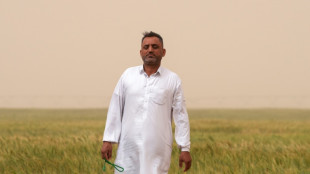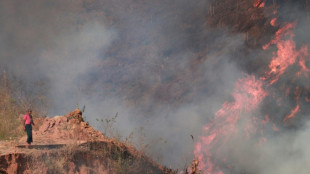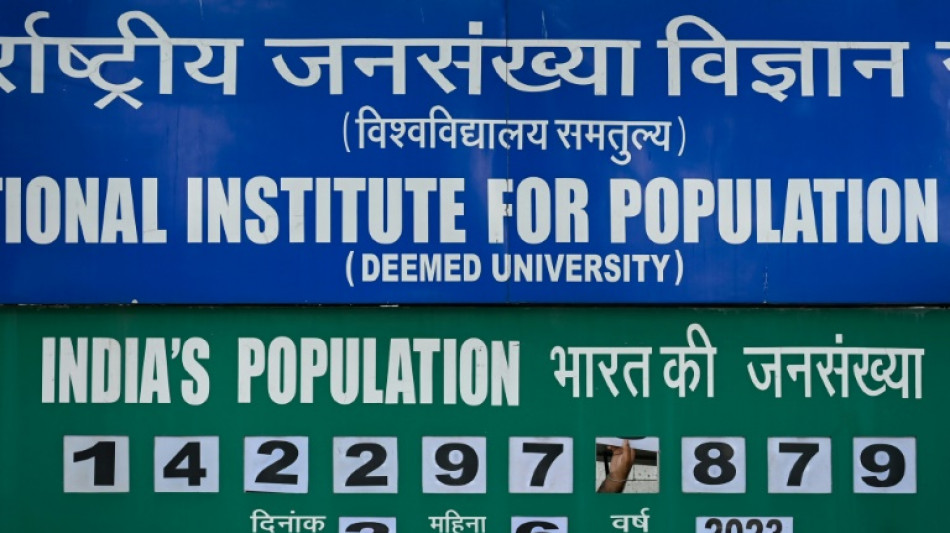
-
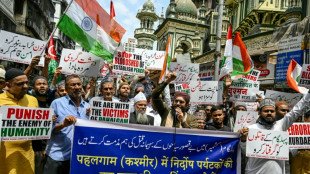 Indian army says new exchange of gunfire with Pakistan
Indian army says new exchange of gunfire with Pakistan
-
Epstein accuser Virginia Giuffre takes own life in Australia: family

-
 Hundreds of buildings damaged, dozens injured in 6.3 Ecuador quake
Hundreds of buildings damaged, dozens injured in 6.3 Ecuador quake
-
India and Pakistan's Kashmir fallout hits economy too

-
 Francis's funeral to be grand farewell to 'pope of the poor'
Francis's funeral to be grand farewell to 'pope of the poor'
-
Pogacar faces defiant Evenepoel at Liege-Bastogne-Liege

-
 Chelsea eye great escape against Barcelona in Women's Champions League
Chelsea eye great escape against Barcelona in Women's Champions League
-
Iran, US to hold new round of high-level nuclear talks

-
 'Energy and effort' pay off for Reds as Blues' woes continue
'Energy and effort' pay off for Reds as Blues' woes continue
-
Albatross and closing birdie lift China's Liu to LPGA Chevron lead

-
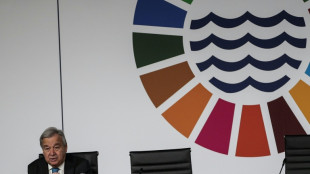 On the horizon? Wave of momentum for high seas treaty
On the horizon? Wave of momentum for high seas treaty
-
Developing countries should fast-track US trade deals: World Bank president
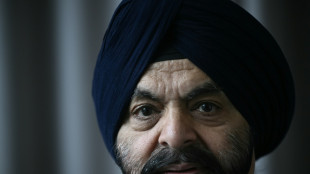
-
 Grizzlies' Morant 'doubtful' for must-win game 4 v Thunder
Grizzlies' Morant 'doubtful' for must-win game 4 v Thunder
-
Trump in Rome for pope funeral in first foreign trip of new term

-
 Trump says Russia-Ukraine deal 'very close' after new Kremlin talks
Trump says Russia-Ukraine deal 'very close' after new Kremlin talks
-
US rookies lead PGA pairs event with McIlroy and Lowry in hunt

-
 Trump tariff promises get a reality check
Trump tariff promises get a reality check
-
Warriors coach Kerr 'relatively optimistic' injured Butler will play game 3

-
 Postecoglou hopes 'Stonecutter's Credo' can inspire Spurs
Postecoglou hopes 'Stonecutter's Credo' can inspire Spurs
-
PSG lose unbeaten Ligue 1 record ahead of Arsenal showdown

-
 Venezuela accuses El Salvador president of 'human trafficking'
Venezuela accuses El Salvador president of 'human trafficking'
-
Own goal takes Sundowns to African final against Pyramids

-
 Scores of buildings damaged, 20 injured in Ecuador quake
Scores of buildings damaged, 20 injured in Ecuador quake
-
US stocks extend rally as market eyes busy calendar next week

-
 Pope's death triggers surge of disinformation he fought against
Pope's death triggers surge of disinformation he fought against
-
Rovanpera takes control of Rally Islas Canarias

-
 Zelensky insists Crimea is Ukrainian as US envoy meets Putin
Zelensky insists Crimea is Ukrainian as US envoy meets Putin
-
Patel and Mendis help Sunrisers beat Kings in Dhoni's 400th T20

-
 Copa del Rey ref statements 'unacceptable': Real Madrid after boycotting final build-up
Copa del Rey ref statements 'unacceptable': Real Madrid after boycotting final build-up
-
Insurance CEO's accused killer pleads not guilty to federal murder charges

-
 FBI arrests Wisconsin judge for shielding undocumented migrant
FBI arrests Wisconsin judge for shielding undocumented migrant
-
Brazil ex-president Collor de Mello jailed for corruption

-
 Zelensky insists Crimea 'belongs' to Ukraine as US envoy meets Putin
Zelensky insists Crimea 'belongs' to Ukraine as US envoy meets Putin
-
Real Madrid boycott Copa del Rey build-up over referee complaints

-
 Trinidad and Tobago votes for parliament, PM, with opposition in lead
Trinidad and Tobago votes for parliament, PM, with opposition in lead
-
IMF chief hails 'constructive' Spring Meetings held under tariff uncertainty

-
 Iran FM Araghchi in Oman ahead of nuclear talks with US
Iran FM Araghchi in Oman ahead of nuclear talks with US
-
Dozens of buildings destroyed, 20 injured in Ecuador quake

-
 Young Barca must 'enjoy' Real Madrid Copa final fight: Flick
Young Barca must 'enjoy' Real Madrid Copa final fight: Flick
-
Pakistan and India border closure separates families
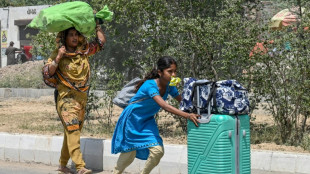
-
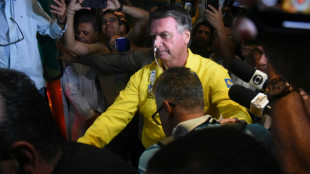 Brazil's Bolsonaro 'stable' after post-surgery setback
Brazil's Bolsonaro 'stable' after post-surgery setback
-
Catholics in secular Cuba hail Francis as 'bridge'
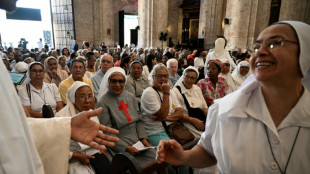
-
 US envoy Witkoff, Putin discuss 'possibility' of direct Russia-Ukraine talks
US envoy Witkoff, Putin discuss 'possibility' of direct Russia-Ukraine talks
-
Community seeks answers after French school knife killing

-
 German prosecutors seek jail terms in VW 'dieselgate' trial
German prosecutors seek jail terms in VW 'dieselgate' trial
-
Sabalenka makes winning start at Madrid Open

-
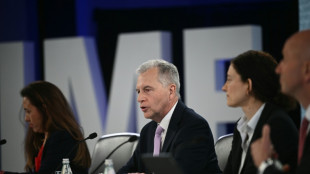 EU, US should de-escalate and negotiate trade deal: IMF Europe director
EU, US should de-escalate and negotiate trade deal: IMF Europe director
-
Russia accuses Ukraine of killing general in car bombing

-
 Emery wants FA Cup glory and Champions League berth for Villa
Emery wants FA Cup glory and Champions League berth for Villa
-
Buildings destroyed, one injured in Ecuador quake


Indian clock tells story of most populous nation
India's first population clock, made up of 10 white numbered cards on a large green metal board, attracts curious passersby who watch it record the story of the world's most populous nation.
The clock -- manually updated every day according to projected estimates and akin to a cricket scoreboard in appearance -- was first erected in 1982 when India was home to more than 684 million people, according to the 1981 government census.
That figure more than doubled in the following decades.
India grew rapidly to overtake China at the top of the population ranks with more than 1.42 billion people, according to a United Nations projection in April.
"An extra slot had already been made in the clock, expecting that we were going to cross one billion," said Professor Chander Shekhar at the International Institute for Population Sciences in Mumbai, where the clock is located.
Overpopulation has long been a concern, with the government establishing a nationwide family planning programme in 1952.
But it was a controversial enforced-sterilisation push in the 1970s that sparked public debates and spurred the institute to create the clock, Shekhar said.
Every day, security guards change the numbers using projections of the natural growth rate -- the difference between the number of births and the number of deaths per 1,000 a year -- derived from government and UN estimates.
"We feel good when we update the board, as passersby can also see the growing population numbers," 56-year-old security supervisor Salunkhe V.V. told AFP.
The current projections estimate that India's population increases by just under 41,000 people a day -- one every two seconds -- or about 15 million a year.
- Boon or bane? -
India's current fertility rate is two births per woman, just under the replacement threshold of 2.1, and down from government estimates of 4.8 in 1981.
The fertility rate varies across the country, with poorer states like Uttar Pradesh and Bihar -- boasting a combined population of more than 325 million -- having the highest rates, according to a 2019 government survey.
In contrast, the two wealthiest states of Maharashtra and Tamil Nadu have fertility rates of 1.56 and 1.54 respectively, far below the average, according to the survey.
Family planning has largely been left to women, with less than one in 10 men using condoms, while female sterilisation was at nearly 38 percent, according to the government's 2019-2021 National Family Health Survey.
Shekhar, 49, was drawn into studying population from a young age, fascinated and "agitated" by large crowds of people everywhere he went.
"I used to hate these numbers," the fertility and social demography expert said.
"But after I got my Master's in Statistics, I thought, 'Let us understand this, is it a problem? Or can it really be solved?'"
Shekhar believes the large numbers don't have to be a ticking time bomb if authorities focus on raising people's quality of life.
Education and health outcomes -- such as falling infant and maternal mortality rates -- have improved since 1982, and India's economy has grown to become the fifth-largest in the world.
But in many cities, residents battle for resources while facing water shortages and air and water pollution.
Youth unemployment for the ages of 15-24 stood at 23.2 percent last year, according to the World Bank.
The overall jobless rate was 7.7 percent in May, data from the Centre for Monitoring Indian Economy showed.
Shekhar said a key concern was that "India will become older before it becomes richer".
"For that (not to happen), we need to have people be skilled, and have employment opportunities for a huge, young, bulge of population."
J.Oliveira--AMWN

